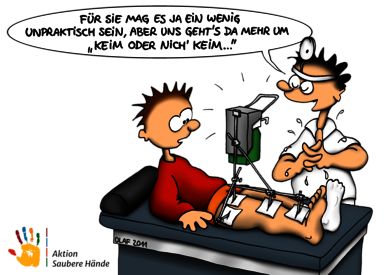Infections in Hospitals
These are pathogens - in hospitals they are primarily bacteria - which can no longer be treated with the antibiotics normally used in treatment. If this is the case, there are usually still so-called “reserve antibiotics” available.
Transmission of MDRO occurs in a hospital either through direct contact with patients who are colonized or who are ill, or else the pathogens are already part of their own body’s microbiome (the microorganisms that are normally present in the body, for example, on the skin in the digestive tract, or other organs).
Nevertheless, the transmission to a healthy individual is very unlikely. The much more probable danger is that the pathogen could be transmitted to someone with a weakened immune-system. An MDRO can lead to an infection or else or can just live without any symptoms - so-called colonization - in digestive tract, on the skin, or in the nasopharynx.
Seventy five to eighty percent of all MDROs in hospitals are brought there by patients. The basic means of preventing transmission to other patients or staff is hand hygiene. If you visit a family member with an MDRO, be sure to disinfect your hands after the visit. These patients are usually in isolation. In such cases, please speak to staff in the ward. But here too the rule is: Besides wearing protective clothing, do not forget to disinfect your hands before and after the visit.
If your child is being treated in a hospital, the most important way to prevent an infection is consistent hand hygiene by the staff. You should also disinfect your hands regularly when caring for your child in the hospital (for example, when changing diapers). It is hard to quantify precisely to what degree contact with other children (in a play area, for example) can lead to transmission.
Most at risk are individuals who have frequent or long stays in the hospital. These are usually seriously or chronically ill patients (for example, dialysis patients). However, residents of long-term care facilities are also at an increased risk. For this reason, special measures are taken when treating patients who have tested positive for NDROs. Here the goal is to prevent transmission to other patients in the institution.
Colonization by an MDRO is determined by swabbing (nasopharynx, anus, possibly wounds and drains). If there is an infection, corresponding material is found (for example, wound exudate in a would infection) in which the pathogen is detected.
Here it is a question of a multifactorial process with a number of various causes. In part it is the result of the changing use of antibiotics in medical treatments. In addition, resistance mechanisms are spreading faster around the world.
The percentage of older patients with serious underlying illnesses has increased and they require more complex forms of treatment. Care of a seriously ill patient whose immune system is compromised requires advanced treatment options with a higher risk.
The most important means of transmission is direct bodily contact, above all, intimate contact, the type that usually happens between family members. You can protect yourself if you perform hand hygiene at the end of the visiting hours or when you leave the room. The patients affected should also be informed of the importance of using a hand disinfectant.


